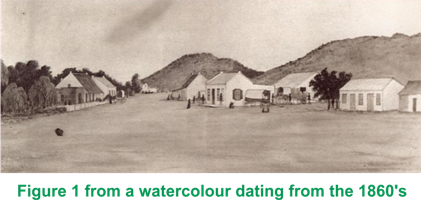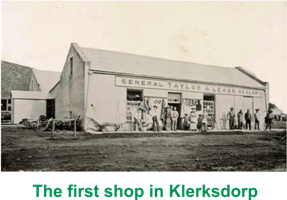Tourism History
A.Short Summery Of The History Of The City Of Matlosana And Its People
 1. Northwest Province, in which City of Matlosana is situated,
was possibly inhabited by people from the Early Stone Age as long ago as 2 million years.
1. Northwest Province, in which City of Matlosana is situated,
was possibly inhabited by people from the Early Stone Age as long ago as 2 million years.
2. About 1000 years ago people from the Iron Age entered the district from the north (possibly from around the present day Congo).
With their better weapons they displaced the people of the (by then) Late Stone Age.
The last of the Iron Age people were overpowered by Mzilikazi in his flight from Chaka in the early 1830s.
3. From the mid-19th Century the influence sphere of the Baralong chief Tau (meaning 'lion') stretched from the Harts River to the Skoonspruit.
The modern day town of Taung (meaning 'Place of the Lion') still reminds us of his rule.
4. The first White inhabitant of Klerksdorp was Hendrik Grobler (probably a hunter)
that settled next to Skoonspruit on was later to become the farm Elandsheuwel.
5. In 1837 a group of 12 Voortrekker families settled on the banks of the Skoonspruit at what is today known as Oudorp.
They established a town and later started calling it "Clercqsdorp"(later to be changed to "Klerksdorp")
after the first magistrate north of the Vaal River, Jacob De Clercq.
6. The first farm was "surveyed" by the Potchefstroom magistrate H. Lombaard by using Elandsheuwel (Eland's Hill)
as centre point and riding for pre-determined periods of time in different directions.
This became the farm Elandsheuwel of Hendrik Grobler.
7. The first shop in Klerksdorp was opened by James A. Taylor in 1865.
In 1870 he takes on a partner, Tomas Leask. Tomas Leask was to become one of the big businessmen of Klerksdorp.
 8. In 1886 gold was discovered in the Klerksdorp District by M.G. Janse van Vuuren
8. In 1886 gold was discovered in the Klerksdorp District by M.G. Janse van Vuuren
9. Due to the rapid development after the discovery of gold, State President S.P.J.
Kruger issued a proclamation on 21 August 1886, according to which Klerksdorp was declared as a town as of 12 September 1888.
10. The first local newspaper, "The Klerksdorp Pioneer" was published in 1887. In November 1888 it was replaced by George Vickers's newspaper "The Representative".
This in turn was replaced by H.M. Guest's "Klerksdorp Mining Record" in August 1899. It still exists today as the "Klerksdorp Record".
11. The Second S.A. War of Independence (Anglo Boer War): The Klerksdorp commando who under the leadership of Gen. Piet Cronje took part of the Siege of Mafeking/Mafikeng,
later departed southwards.
With the Battle of Paardeberg on 18 February 1900 most were taken prisoner. Gen. Andries Cronje, brother of Piet Cronje, was then put in command of the Klerksdorp Commando
12. Immediately before and during the Anglo Boer War, African people were for the most part living either in town in housing situated on the properties of their employers,
or in traditional homesteads surrounding town.
During the Anglo Boer War, a separate concentration camp was erected where Ellaton is situated today,
where African people were incarcerated under extremely poor conditions. Many people died there from malnutrition and disease.
At the end of the War, the inhabitants requested permission from authorities to permanently settle in the remnants of this concentration camp.
From the squalor gradually arose a vibrant community proudly named Makweteng by its inhabitants
13. From 1950 onwards the inhabitants of Makweteng were forcibly removed by the Apartheid government and relocated in new townships like Kanana, Jouberton, Tigane etc.
14. The area where Hartbeesfontein is situated today was known by local people as Tsemela
15. Under Apartheid Black people were becoming less and less welcome to stay in so-called White areas like Hartbeesfontein.
In 1939 Black people still living in Hartbeesfontein were forcibly removed to go and live on a farm outside Hartbeesfontein.
This gave rise to the township of Tigane.
16. Local people like Mfana Majova, Delekile Khoza and Casey Sindi offered their lives during the struggle against Apartheid to bring freedom to our country
17. During September 1996 the Truth and Reconciliation Commission (TRC) held hearings in Jouberton.Read More about them on our Freedom Squares Page
These hearings were chaired by Arch Bishop Desmond Tutu, who was himself born in Klerksdorp in 1931
Copyright (c) City Of Matlosana Official Website. All rights reserved.
Content of this website belongs to the City Of Matlosana. For More Information contact
Contact The Web Master